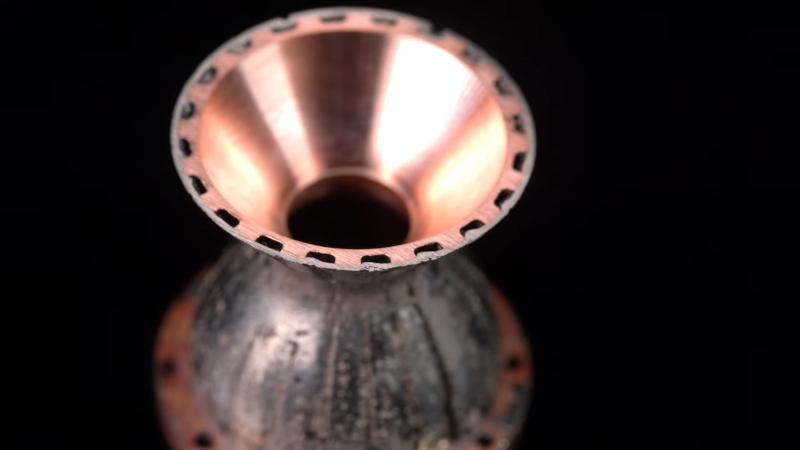OK folks, let's get going! Welcome back to the Hack Chat, sorry for the long absence. I'm Dan, I'll be moderating today along with Dusan as we welcome Eric Utley to talk about design for 3D printing.
I saw Eric on much earlier today; still out there, Eric?
![]() I am still here!
I am still here!
 Hi Dan, welcome everyone!
Hi Dan, welcome everyone!
 Hi Eric, welcome aboard! Can you kick things off with a little about yourself and your background?
Hi Eric, welcome aboard! Can you kick things off with a little about yourself and your background?
 Hi Dule!
Hi Dule!
![]() Yes, I have been involved in additive manufacturing (aka 3D printing) for over 15 years now. I work with production technologies primarily like SLA, SLS, and MJF
Yes, I have been involved in additive manufacturing (aka 3D printing) for over 15 years now. I work with production technologies primarily like SLA, SLS, and MJF
![]() I have a harder time coming up with things I haven't printed than things I have
I have a harder time coming up with things I haven't printed than things I have
 I've heard of the others, but help me out with MJF...
I've heard of the others, but help me out with MJF...
![]() yes that is Multi Jet Fusion, a tech developed by HP. It uses a series of printer heads that deposits 'fusing agent' into plastic powder and the whole build chamber is hit with heat. The fusing agent heats up from the light and sinters the powder.
yes that is Multi Jet Fusion, a tech developed by HP. It uses a series of printer heads that deposits 'fusing agent' into plastic powder and the whole build chamber is hit with heat. The fusing agent heats up from the light and sinters the powder.
![]() It prints very fast, we can build hundreds of parts at a time in an overnight print. The material is very general purpose (nylon)
It prints very fast, we can build hundreds of parts at a time in an overnight print. The material is very general purpose (nylon)
![]() The powder acts as support structure, so it requires no scaffolding. If we get really intricate designs like neural networks or tree roots it is the best for shapes like that, but also good at end-use production printed plastic parts
The powder acts as support structure, so it requires no scaffolding. If we get really intricate designs like neural networks or tree roots it is the best for shapes like that, but also good at end-use production printed plastic parts
 OK, I think I've seen that before. Also think I've seen DIY versions that spray a thin glue as the binder? Maybe, anyway
OK, I think I've seen that before. Also think I've seen DIY versions that spray a thin glue as the binder? Maybe, anyway
![]() its not quite the same, what you are referring to is 'binder jetting' where blue/binder is placed on powder to glue it together. The MJF is a heat driven process that actually melts the powder to sinter it
its not quite the same, what you are referring to is 'binder jetting' where blue/binder is placed on powder to glue it together. The MJF is a heat driven process that actually melts the powder to sinter it
![]() We actually do not do any binder jetting, but there are binder jetting printing processes out there that can print in full color plastics or even print metal parts
We actually do not do any binder jetting, but there are binder jetting printing processes out there that can print in full color plastics or even print metal parts
 Got it. And these are all "big boy" printers, right? Industrial units as opposed to the ones we're more used to, I'd imagine
Got it. And these are all "big boy" printers, right? Industrial units as opposed to the ones we're more used to, I'd imagine
![]() yes correct, these would be industrial printers not seen in home use. Some are specialized for niche parts (like Micro Stereolithography for very small parts) and some like MJF are more general purpose
yes correct, these would be industrial printers not seen in home use. Some are specialized for niche parts (like Micro Stereolithography for very small parts) and some like MJF are more general purpose
![]() This is our largest printer: It can print metal parts the size of an inline 4 engine block
This is our largest printer: It can print metal parts the size of an inline 4 engine block
 what are the kinds of companies primarily printing parts that large?
what are the kinds of companies primarily printing parts that large?
 Is that actually a use case for a printer like this? IOW, do people need to print something like an engine block for prototyping, etc? Or is it more a case of a huge print bed being used to print multiple items at once?
Is that actually a use case for a printer like this? IOW, do people need to print something like an engine block for prototyping, etc? Or is it more a case of a huge print bed being used to print multiple items at once?
![]() Those are very much aerospace parts. We run both Inconel and aluminum on those large metal printers. Inconel is a nickel based 'superalloy' capable of withstanding very high temperatures. Components for rockets, satellites, and unmanned drones.
Those are very much aerospace parts. We run both Inconel and aluminum on those large metal printers. Inconel is a nickel based 'superalloy' capable of withstanding very high temperatures. Components for rockets, satellites, and unmanned drones.
![]() sometimes it will be something outside of aerospace, like custom manufacturing equipment or prototypes of parts that will eventually be cast
sometimes it will be something outside of aerospace, like custom manufacturing equipment or prototypes of parts that will eventually be cast
![]() We can print heat sinks and other designs in aluminum. The printing allows for internal cooling channels to make for efficient cooling without an extensive assembly of welding multiple parts together.
We can print heat sinks and other designs in aluminum. The printing allows for internal cooling channels to make for efficient cooling without an extensive assembly of welding multiple parts together.
 We did a story about how rocket nozzles were manufactured with internal cooling channels before AM came along and made that easier. The process was really cool.
We did a story about how rocket nozzles were manufactured with internal cooling channels before AM came along and made that easier. The process was really cool.
![]() printing in metal allows aerospace to skeletonize the designs and remove as much weight as possible, they are easily the earliest adopters of printing in metal
printing in metal allows aerospace to skeletonize the designs and remove as much weight as possible, they are easily the earliest adopters of printing in metal

https://hackaday.com/2023/04/23/the-shuttle-engine-needed-3d-printing-but/
The Shuttle Engine Needed 3D Printing, But...
If we asked you to design a circuit to blink a flashing turn signal, you would probably reach for a cheap micro or a 555. But old cars used bimetallic strips in a thermomechanical design. Why? Because, initially, 555s and microcontrollers weren't available.
 what challenges have you faced when printing things in metal? is it very different than plastic?
what challenges have you faced when printing things in metal? is it very different than plastic?
![]() Yes it reminds me of the Rocketeer movie. In the movie, the reason the jetpack didnt explode was because it had internal cooling channels lol
Yes it reminds me of the Rocketeer movie. In the movie, the reason the jetpack didnt explode was because it had internal cooling channels lol
![]()
A Deep Dive into Metal 3D Printing.pdf
7 MB
![]() Yes metal has quite a few restrictions, this document is a good resource
Yes metal has quite a few restrictions, this document is a good resource
![]() the main challenge is the material contracting as it cools and trying to mitigate that as much as possible
the main challenge is the material contracting as it cools and trying to mitigate that as much as possible
![]() an ideal metal printed part (DMLS is the printing acronym) will have a uniform wall thickness. As the part prints you want the transition from layer-to-layer be as gradual as possible.
an ideal metal printed part (DMLS is the printing acronym) will have a uniform wall thickness. As the part prints you want the transition from layer-to-layer be as gradual as possible.
 One thing that always bothered me about SLS conceptually is that it seems like the powder bed would take away the need for supports to be printed. But I guess that's not the case, right?
One thing that always bothered me about SLS conceptually is that it seems like the powder bed would take away the need for supports to be printed. But I guess that's not the case, right?
![]() The support requirements are quite extensive and the metal parts need supports more than you would see on a desktop printed part. A lot of the aerospace and medical companies are learning how to design parts so that they need little-to-no support structure. The designs march taller throughout the print very organically, like a tree growing
The support requirements are quite extensive and the metal parts need supports more than you would see on a desktop printed part. A lot of the aerospace and medical companies are learning how to design parts so that they need little-to-no support structure. The designs march taller throughout the print very organically, like a tree growing
![]() SLS and MJF do not require supports, but those are plastic powder. DMLS is a metal printing tech that is very similar, but because how aggressively metal contracts as it cools it requires supports
SLS and MJF do not require supports, but those are plastic powder. DMLS is a metal printing tech that is very similar, but because how aggressively metal contracts as it cools it requires supports
![]() In metal, the layers are very thin (20-30 microns, ~1/4 sheet of paper) and the metal wants to curl upwards as it cools. If it curls too much it can break above the layer thickness and cause build issues
In metal, the layers are very thin (20-30 microns, ~1/4 sheet of paper) and the metal wants to curl upwards as it cools. If it curls too much it can break above the layer thickness and cause build issues
![]() so they need to be nailed down with supports
so they need to be nailed down with supports
 Gotcha -- given how much metal moves when you weld it, I can see how that would be a problem and how supports would help.
Gotcha -- given how much metal moves when you weld it, I can see how that would be a problem and how supports would help.
 So, are there any kinds of designs that just aren't appropriate for specific technologies? Do we need to keep that in mind when coming up with a design?
So, are there any kinds of designs that just aren't appropriate for specific technologies? Do we need to keep that in mind when coming up with a design?
![]() Yes it largely comes down to the design, material, and quantity most of the time. It makes sense in 3D printing to only use the material you need and avoid overly chunky designs, not only from a cost perspective but also 3DP tends to print parts with a uniform wall thickness the most accurately
Yes it largely comes down to the design, material, and quantity most of the time. It makes sense in 3D printing to only use the material you need and avoid overly chunky designs, not only from a cost perspective but also 3DP tends to print parts with a uniform wall thickness the most accurately
 Seems like we hear about metal 3D printing for a lot of different applications (or at least its potential) these days. Have there been any innovations in DMLS that have led to this growth in popularity, or is it more engineers just learning to better utilize it?
Seems like we hear about metal 3D printing for a lot of different applications (or at least its potential) these days. Have there been any innovations in DMLS that have led to this growth in popularity, or is it more engineers just learning to better utilize it?
![]() Try to keep the parts as uniform thickness as possible. If you have an area that goes thick-to-thin or vice-versa it is good to add a radii or fillet to make the transition more gradual. A good rule of thumb is about 1% wall thickness VS size of the part. So a 6 inch part could be .060" nominal wall thickness
Try to keep the parts as uniform thickness as possible. If you have an area that goes thick-to-thin or vice-versa it is good to add a radii or fillet to make the transition more gradual. A good rule of thumb is about 1% wall thickness VS size of the part. So a 6 inch part could be .060" nominal wall thickness
![]() there has definitely been an uptick of engineers who actually know how to design for the tech. I feel like that trend really kicked into high gear about 5 years ago.
there has definitely been an uptick of engineers who actually know how to design for the tech. I feel like that trend really kicked into high gear about 5 years ago.
 Do contract printers generally do a design review with clients before starting a print run? Seems like you'd want to catch errors or optimize the design before committing a lot of print resources.
Do contract printers generally do a design review with clients before starting a print run? Seems like you'd want to catch errors or optimize the design before committing a lot of print resources.
![]() A big part too was aerospace realized it reduced a lot of their logistics by consolidating assemblies. Like GE for example may now 3D print a single metal piece instead of welding 20 different parts together. This not only saves them the labor, but if the # of parts needed to build a plane drops from 50k to 5k its waaaaay less management making sure all those parts are qualified for production
A big part too was aerospace realized it reduced a lot of their logistics by consolidating assemblies. Like GE for example may now 3D print a single metal piece instead of welding 20 different parts together. This not only saves them the labor, but if the # of parts needed to build a plane drops from 50k to 5k its waaaaay less management making sure all those parts are qualified for production
![]() Yes, we review every part before it prints. If we identify a manufacturing risk our quality certifications require us to notify the customer and get approval/acknowledgement before we proceed with manufacturing. Our website gives some instant automated feedback on 3D printed parts on wall thicknesses too thin and gaps too narrow to successfully print
Yes, we review every part before it prints. If we identify a manufacturing risk our quality certifications require us to notify the customer and get approval/acknowledgement before we proceed with manufacturing. Our website gives some instant automated feedback on 3D printed parts on wall thicknesses too thin and gaps too narrow to successfully print
![]() That is what I do daily, have conversations on 3D printed parts our customers have uploaded and talk through what is the best tech and approach for what they want to achieve
That is what I do daily, have conversations on 3D printed parts our customers have uploaded and talk through what is the best tech and approach for what they want to achieve
 What are some good practices for designing parts for 3D printing? Like when you are reviewing a part what features let you know the person/team who designed them knew what they were doing? Obviously, it will depend on the technology to be used, but anything that comes to mind
What are some good practices for designing parts for 3D printing? Like when you are reviewing a part what features let you know the person/team who designed them knew what they were doing? Obviously, it will depend on the technology to be used, but anything that comes to mind
![]() A uniform wall thickness goes a long way with a lot of our technologies, it really cuts down on risk of material shrink. 1% is a good rule of thumb, so 4 inch part could be .040" thick (ideally, plenty of wiggle room here). Adding a radii/fillet to any hard interior edges helps reduce stress.
A uniform wall thickness goes a long way with a lot of our technologies, it really cuts down on risk of material shrink. 1% is a good rule of thumb, so 4 inch part could be .040" thick (ideally, plenty of wiggle room here). Adding a radii/fillet to any hard interior edges helps reduce stress.
![]() 45 deg and steeper is a self-supporting angle for nearly all 3DP techs that require supports, that is a useful thing to keep in mind. If you can have things march up at 45 deg or steeper that is ideal and will reduce or even eliminate need for supports
45 deg and steeper is a self-supporting angle for nearly all 3DP techs that require supports, that is a useful thing to keep in mind. If you can have things march up at 45 deg or steeper that is ideal and will reduce or even eliminate need for supports
 I've heard the same filleting advice for FDM designs too
I've heard the same filleting advice for FDM designs too
 Any problem with round holes like we see with traditional FFF?
Any problem with round holes like we see with traditional FFF?
![]() While designing you will want to pick an ideal orientation and go with it and try to optimize for that orientation
While designing you will want to pick an ideal orientation and go with it and try to optimize for that orientation
![]() yes sidewall holes are typically less accurate than holes in the XY plane. For SLS/MJF we drill holes after they are printed as part of standard processing. For metal printing we will often secondary machine the hole to be more accurate if it is required
yes sidewall holes are typically less accurate than holes in the XY plane. For SLS/MJF we drill holes after they are printed as part of standard processing. For metal printing we will often secondary machine the hole to be more accurate if it is required
![]() https://www.protolabs.com/resources/design-for-3d-printing-toolkit/ this is a useful resource, it has the minimum wall thicknesses of all our available materials and resolutions
https://www.protolabs.com/resources/design-for-3d-printing-toolkit/ this is a useful resource, it has the minimum wall thicknesses of all our available materials and resolutions
 Seems like post-processing is a big part of what you do. There must be a balance point where it just makes sense to machine the entire part if it needs a ton of post-processing. Who makes that call?
Seems like post-processing is a big part of what you do. There must be a balance point where it just makes sense to machine the entire part if it needs a ton of post-processing. Who makes that call?
![]() we review the drawing with the customer. We very commonly will print parts in metal and secondary machine them, we have a full CNC shop that does nothing but machine metal printed parts. Ideally the printing gets you ~95% there and the machining is the critical stuff that needs to be accurate, smooth, or both
we review the drawing with the customer. We very commonly will print parts in metal and secondary machine them, we have a full CNC shop that does nothing but machine metal printed parts. Ideally the printing gets you ~95% there and the machining is the critical stuff that needs to be accurate, smooth, or both
![]() A good rule of thumb is if you can 3-axis cnc machine it, it will be faster and cheaper to do so than to print it. That is nearly a daily occurrence that someone will ask us to quote printing a part in metal and we will recommend CNC instead
A good rule of thumb is if you can 3-axis cnc machine it, it will be faster and cheaper to do so than to print it. That is nearly a daily occurrence that someone will ask us to quote printing a part in metal and we will recommend CNC instead
![]() But yes printing a metal part and machining most or all of the exterior is very expensive and risky, and would only be done for something that absolutely required it like a part with complex internal geometry that could not be machined
But yes printing a metal part and machining most or all of the exterior is very expensive and risky, and would only be done for something that absolutely required it like a part with complex internal geometry that could not be machined
![]() We have some customers who come from a casting background, and they seem to be very plug-and-play with metal printing. The concept is the same in that the manufacturing process gets you to a 95% there part, and the secondary machining is done on just the most critical features.
We have some customers who come from a casting background, and they seem to be very plug-and-play with metal printing. The concept is the same in that the manufacturing process gets you to a 95% there part, and the secondary machining is done on just the most critical features.
 Except no draft angle
Except no draft angle
![]() right we dont care a whole lot about draft angles
right we dont care a whole lot about draft angles
![]() There are some industry trends of some industries moving away from casting and using metal 3D printing. The printing process is better at high mix, low volume and casting will be better at higher volumes and at larger parts
There are some industry trends of some industries moving away from casting and using metal 3D printing. The printing process is better at high mix, low volume and casting will be better at higher volumes and at larger parts
 That almost seems counterintuitive, though, given the cost of creating sand molds for casting massive numbers of parts. Seems very labor intensive, and skilled labor at that.
That almost seems counterintuitive, though, given the cost of creating sand molds for casting massive numbers of parts. Seems very labor intensive, and skilled labor at that.
![]() Yes but printing starts running out of efficiencies once you fill out the platform. Scaling of additive is also very sensitive to size. If the printer bed is 10 inches by 10 inches, once a part is 5X5 or larger you can only print 1 at a time and your scalability is very low
Yes but printing starts running out of efficiencies once you fill out the platform. Scaling of additive is also very sensitive to size. If the printer bed is 10 inches by 10 inches, once a part is 5X5 or larger you can only print 1 at a time and your scalability is very low
![]() the inverse side is if the part is small we can make a whole bunch at one time. We made 3000 parts in 2 days one time for one project, but it was small and about the size of your pinky finger
the inverse side is if the part is small we can make a whole bunch at one time. We made 3000 parts in 2 days one time for one project, but it was small and about the size of your pinky finger
 Well, we're at the top of the hour now, which is when we like to offer the host a chance to bow out and get back to work. So I'll say a big thanks to Eric for his time today, I know I learned a lot. Thanks so much, Eric. And thanks to everyone for coming along for the ride.
Well, we're at the top of the hour now, which is when we like to offer the host a chance to bow out and get back to work. So I'll say a big thanks to Eric for his time today, I know I learned a lot. Thanks so much, Eric. And thanks to everyone for coming along for the ride.
 Yea, thanks a lot!
Yea, thanks a lot!
![]() yes thank you all, feel free to reach out to me if you guys have any questions.
yes thank you all, feel free to reach out to me if you guys have any questions.
![]() it was fun!
it was fun!
 Thanks a lot Eric
Thanks a lot Eric
 Dan Maloney
Dan Maloney
Discussions
Become a Hackaday.io Member
Create an account to leave a comment. Already have an account? Log In.